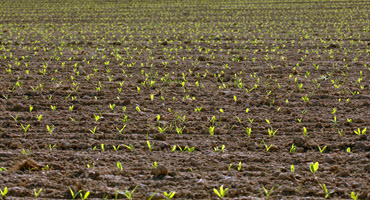U.S. growers have seeded 56 percent of this year’s soybean crop
By Diego Flammini
Staff Writer
Farms.com
American farmers have planted more than 50 percent of the national 2018 soybean crop.
Growers have seeded 56 percent of U.S. soybeans, the USDA’s May 22 Weekly Weather and Crop Bulletin says. That number is up from 35 percent last week and is 6 percent higher than at this time a year ago.
Soybean producers in Louisiana have planted 93 percent of their crops, which is the highest among the 18 states recorded.
Growers in South Dakota have played 24 percent of their soybeans, which is the lowest in the nation. That number represents a 20 percent increase from last week.
The crop continues to emerge.
Overall, 26 percent of the soybean crop has emerged, the USDA says. That number is up from 10 percent last week and up from 17 percent recorded at this time last year.
In Louisiana, 84 percent of soybeans have emerged, which is the highest in the U.S.
Corn
National corn seeding increased by 19 percent from last week’s USDA report.
Producers have planted 81 percent of their corn, which is up from 62 percent last week.
Farmers in Tennessee, North Carolina, Missouri and Illinois have all planted more than 90 percent of their respective states’ corn acres.
Corn growers in Pennsylvania have planted 35 percent of their corn, which is the lowest of the 18 documented states.
Half of the 2018 corn crop has emerged. That number is up from 28 percent last week.

frankoppermann/iStock/Getty Images Plus
About 89 percent of North Carolina’s corn crop has emerged, which is the highest in the country. In contrast, only 8 percent of North Dakota’s corn crop has emerged.
Wheat
Altogether, 61 percent of the winter wheat crop has headed. That’s up from 45 percent last week, but still down 10 percent from this time last year, the USDA says.
All of California’s winter wheat has headed, while no winter wheat has headed in either Montana or South Dakota.
The USDA ranked 29 percent of the winter wheat crop as good. That’s on par with last week’s report.
Spring wheat planting continues across the U.S.
Growers have seeded 79 percent of the national spring wheat crop. That number is up from 58 percent last week.
Farmers in Idaho, South Dakota and Washington have planted more than 90 percent of state spring wheat crops.
The crop continues to emerge.

About 37 percent of the U.S. spring wheat crop has emerged, the USDA reports. That number is up from 14 percent last week, but still down from 59 percent at this time in 2017.
And 75 percent of spring wheat crop in Washington has emerged, which is the highest of the six recorded states.
Suitable fieldwork days
The states with the most suitable fieldwork days for the week ending May 20 were:
California and Arizona – 7
Utah – 6.9
New Mexico – 6.8
The states with the fewest suitable fieldwork days were:
Maryland and Delaware – 0
Pennsylvania – 1.5
New Jersey – 2
Weekly precipitation levels
State | Precipitation (inches) | Weather Station |
Illinois | 2.57 | Chicago/O’Hare |
Indiana | 3.57 | South Bend |
Iowa | 1.99 | Dubuque |
Kentucky | 2.94 | Lexington |
Michigan | 1.39 | Grand Rapids |
Missouri | 1.86 | Saint Louis |
New York | 1.58 | Binghamton |
Pennsylvania | 4.25 | Middletown |
Tennessee | 2.74 | Nashville |
The next Weekly and Weather Crop Bulletin will be released on Tues. May 29.